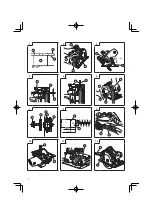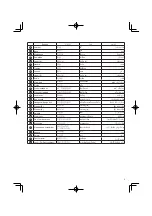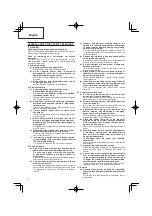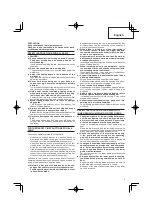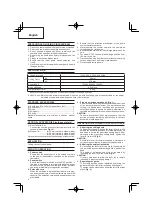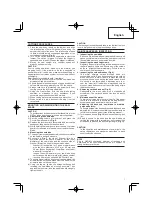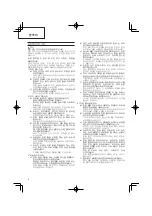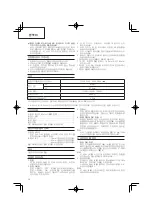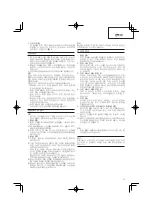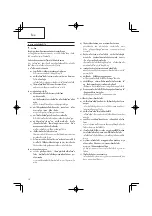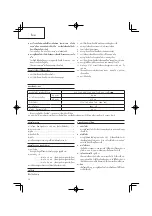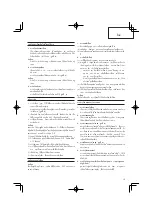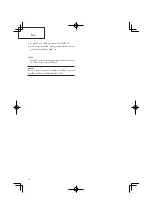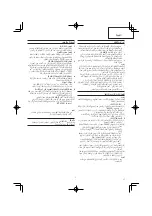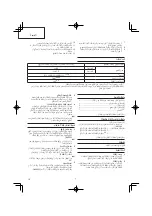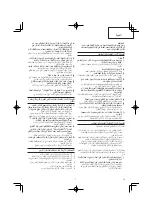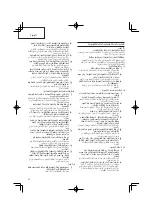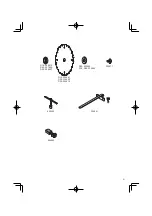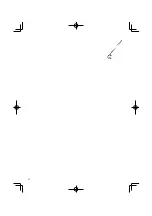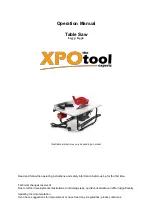
7
English
CUTTING PROCEDURES
1. Place the saw body (base) on the lumber, and align
the intended line of cut with the saw blade, using the
notch at the front of the base. This relationship of base
to lumber should remain unchanged regardless of the
inclination of the base (
Fig. 5
).
2. Turn ON the switch before the saw blade contacts the
lumber. The switch is turned ON when the trigger is
squeezed, and turned OFF when the trigger is released.
3. Moving the saw straight at a constant speed will
produce optimum cutting.
CAUTION
Prior to cutting operation, make sure the material you
are going to cut. If the material to be cut is expected to
generate harmful / toxic dusts, make sure the dust bag or
appropriate dust extraction system is connected with dust
outlet tightly.
Wear the dust mask additionally, if available.
○ Before starting to saw, confirm that the saw blade has
attained full-speed revolution.
○ Should the saw blade be stopped or made an abnormal
noise while operating, promptly turn OFF the switch.
○ Always take care in preventing the power cord from
coming near to the revolving saw blade.
○ Using the Circular Saw with the saw blade facing
upwards or sideways is very hazardous. Such
uncommon applications should be avoided.
○ When cutting material, always wear eye protection.
○ When finished a job, disconnect the plug from the
receptacle.
MOUNTING AND DISMOUNTING THE SAW
BLADE
CAUTION
To avoid serious accident, ensure that the switch is in the
OFF position, and the power source is disconnected.
1. Dismounting the saw blade
(1) Set the cutting volume at maximum, and place the
Circular Saw as shown in
Fig. 6
.
(2) Depress the lock lever, lock the spindle, and remove the
hexagonal-flange bolt with the box wrench.
(3) While holding the lower guard lever to keep the lower
guard fully retracted into the saw cover, remove the saw
blade.
2. Mounting the saw blade
(1) Thoroughly remove any sawdust which has accumulated
on the spindle, bolt and washers.
(2) As shown in
Fig. 7
, the side of Washer (A) with a
projected center the same diameter as the inner
diameter of the saw blade and the concave side of
Washer (B) must be fitted to the saw blade sides.
* Washer (A) is supplied for 3 types of saw blades
with the hole diameters of 16 mm, 20 mm and
30 mm. (When buying the Circular Saw, one type of
washer (A) is supplied.)
In case the hole diameter of your saw blade does
not correspond to that of washer (A), please contact
the shop where you purchased the Circular Saw.
(3) To assure proper rotation direction of the saw blade, the
arrow direction on the saw blade must coincide with the
arrow direction on the saw cover.
(4) Using the fingers, tighten the hexagonal-flange bolt
retaining the saw blade as much as possible. Then
depress the lock lever, lock the spindle, and thoroughly
tighten the bolt.
CAUTION
After having attached the saw blade, reconfirm that the lock
lever is firmly secured in the prescribed position.
MAINTENANCE AND INSPECTION
1. Inspecting the saw blade
Since use of a dull saw blade will degrade efficiency and
cause possible motor malfunction, sharpen or replace
the saw blade as soon as abrasion is noted.
2. Inspecting the mounting screws
Regularly inspect all mounting screws and ensure that
they are properly tightened. Should any of the screws
be loose, retighten them immediately. Failure to do so
could result in serious hazard.
3. Inspecting the carbon brushes (Fig. 8)
The motor employs carbon brushes which are
consumable parts. Since an excessively worn carbon
brush can result in motor trouble, replace the carbon
brushes with new ones having the same carbon brush
No. shown in the figure when it becomes worn to or
near the “wear limit”. In addition, always keep carbon
brushes clean and ensure that they slide freely within
the brush holders.
4. Replacing carbon brushes (Fig. 9)
Disassemble the brush caps with a slotted-head
screwdriver. The carbon brushes can then be easily
removed.
5. Maintenance of the motor
The motor unit winding is the very “heart” of the power
tool. Exercise due care to ensure the winding does not
become damaged and/or wet with oil or water.
6. Adjusting the base and saw blade to maintain
perpendicularity:
The angle between the base and the saw blade has been
adjusted to 90°, however should this perpendicularity be
lost for some reason, adjust in the following manner:
(1) Turn the base face up (
Fig. 10
) and loosen the wing-bolt
(A).
(2) Apply a square to the base and the saw blade and
turning the screw with a screwdriver, shift the position
of the base to produce the desired right angle (
Fig. 11
).
CAUTION
In the operation and maintenance of power tools, the
safety regulations and standards prescribed in each
country must be observed.
NOTE
Due to HiKOKI’s continuing program of research and
development, the specifications herein are subject to
change without prior notice.
Summary of Contents for C 7ST
Page 2: ...1 2 3 4 5 6 7 8 9 10 11 12 2 43 6 mm 17 mm 0 45 ...
Page 22: ...22 ...
Page 23: ...23 ...


